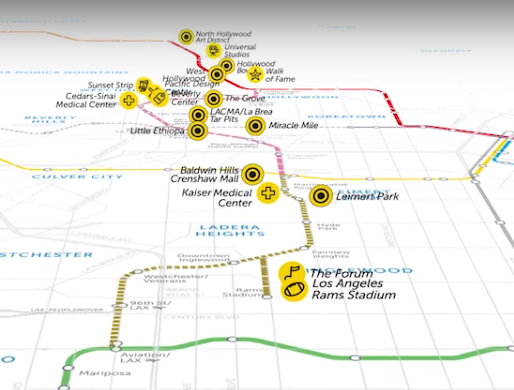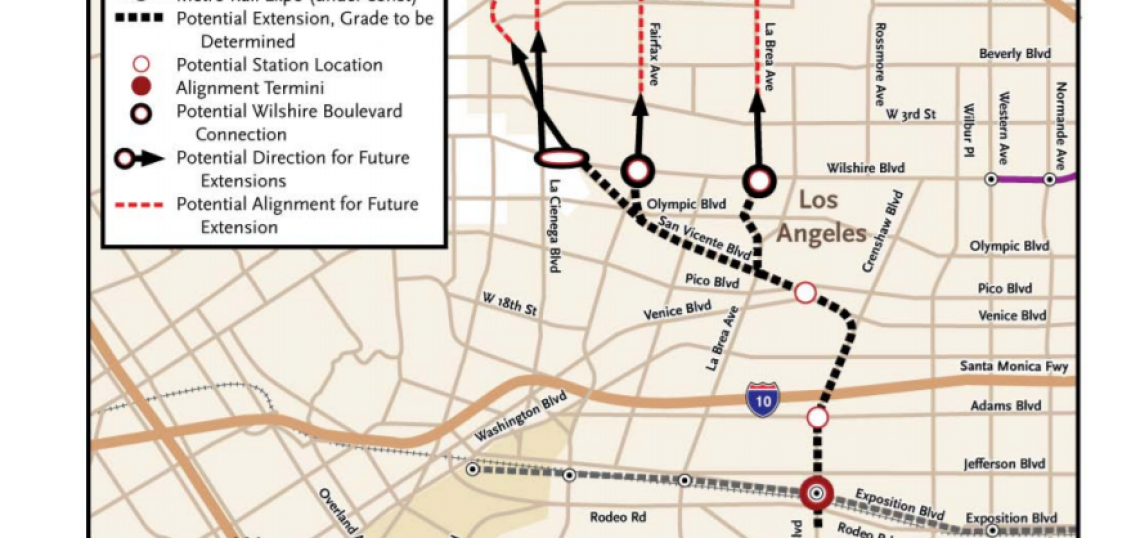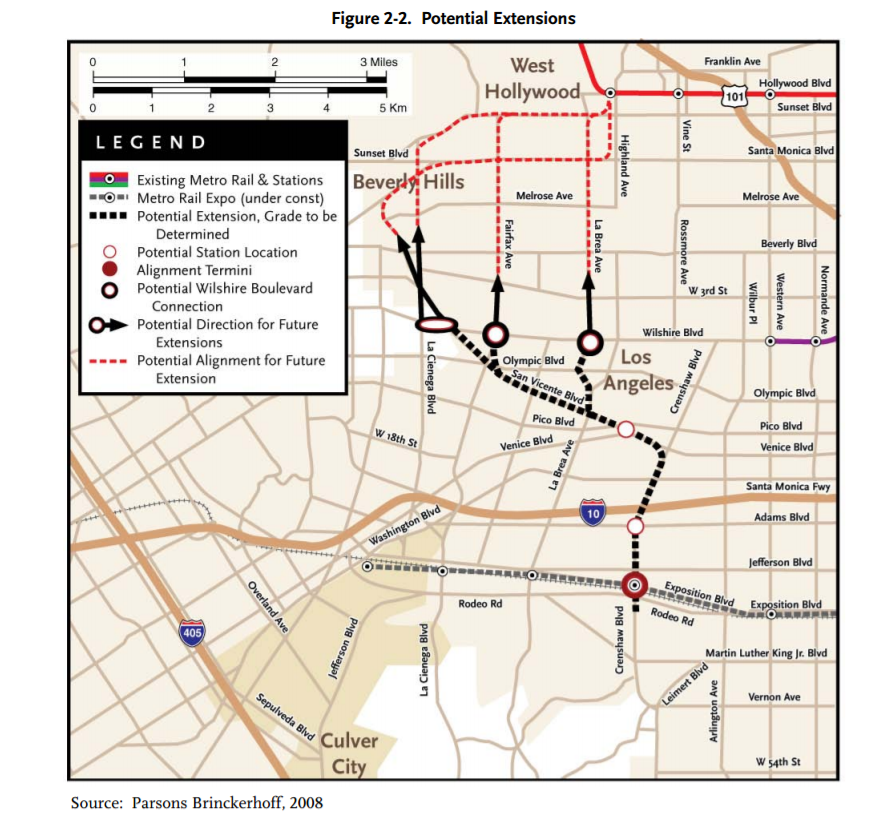With the era of Measure M beginning at Metro, one rail project that is likely to be getting underway in a relative hurry is the extension of the Crenshaw/LAX light rail line, north to a terminus at the Hollywood/Highland Red Line station. Metro has already begun studying La Brea, Fairfax, La Cienega and San Vicente as potential corridors for the line, with a final selection to be made in 2018. The line is among the most talked about of the newly-funded transit projects, in part because the Westside still represents the aspirational face that Los Angeles enjoys presenting to the world, as opposed to the working-class city of slipping wages and rising rents that feeds Metro’s existing ridership.
But another reason the line has made headlines is that West Hollywood has lobbied hard for a route that would serve the city generously via San Vicente and Santa Monica Boulevards. Back in June, Lindsey Horvath, Councilmember for the city of West Hollywood, together with Mayor James Butts of Inglewood, wrote an open letter calling on Metro to accelerate the construction of the Green Line rail extension and the extension of the Crenshaw line north to Hollywood. The letter was part of a euphemistic "Finish the Lines" campaign that leaned on insinuations of broken promises by Metro. As Horvath and Butts concluded, "If Metro disappoints these voters again, it could put the entire $120-billion transit expansion plan at risk."
Now, the Measure M campaign saw no shortage of “me first” thinking from cities, but West Hollywood’s involvement is somewhat unique, especially among rail-seeking cities, and certainly worth discussing. The city wants rail badly and it has the money to fight for it, having previously hired Sam Schwartz Engineering in 2010 to lobby for the West Hollywood branch of the Purple Line, albeit unsuccessfully. Despite identifying the Santa Monica Boulevard corridor as having sufficient ridership potential to justify a rail investment, Metro did not have enough funds to build the Purple Line Alternative 5 that would have served the cities of Santa Monica and West Hollywood. Nor did the MTA see the feds as likely to pay extra for extension, which did not score well on the FTA’s cost-effectiveness scale.
Undeterred by this, when it became clear that the Crenshaw extension would receive funding from the tax that became Measure M, West Hollywood hired Fehr and Peers, a company that Metro has worked with on past studies, to conduct its own analysis and help push the MTA to select the San Vicente/Santa Monica-serving route originally sketched in the feasibility study. The city council was divided on which tack to take with Metro, with four of the five members initially supporting a hardball approach that would have seen the city place its own competing sales tax increase on the ballot in an attempt to push Metro’s measure up against the state’s 10% cap on municipal sales taxes. The lone holdout against this plan happened to be Lindsey Horvath, who favored relationship-building to standoffishness.

Hers was the strategy that prevailed. In addition to the work done by Fehr and Peers, West Hollywood also organized the expertly-acronymed West Hollywood Advocates for Metro (WHAM) and the All on Board Coalition. You would be forgiven for confusing the two groups, which appear to be quite similar in composition. The latter is nominally composed of the other community groups that support the San Vicente route, although some of those groups have publicly and contentiously withdrawn their support. Aside from West Hollywood officials, the most prominent supporter of the All on Board Coalition is the city of Inglewood, which is attempting to advance a questionable plan to extend a rail spur to its new NFL stadium.
Perhaps unsurprisingly (Mayor Butts sits on the Metro Board of Directors), requests to accelerate the Crenshaw line have thus far found a receptive audience in the MTA. The extension, which had already had its start date moved up to 2041 from 2049, could begin construction in 2020, according to a letter CEO Phil Washington wrote Lindsey Horvath in September. That letter sealed it, and WeHo’s city council voted unanimously to support Measure M the following week. That West Hollywood has thus far succeeded to such a degree is remarkable. The city lacks the population or job base of the county’s larger cities. It doesn’t have a shovel-ready project in an existing corridor, as the Gold Line foothill communities do. The city doesn’t have members of the state legislature going to bat for it, the way that the San Fernando Valley and the Gateway cities do. West Hollywood has gotten far with what is essentially a publicity campaign.
The comparatively breakneck pace at which things are moving for the Crenshaw extension makes this an appropriate time to reflect on the potential routes. We know what West Hollywood wants, but which corridor would make the best addition to the county’s rail network? In the next post, I will discuss relative benefits and costs of each option and how they might serve L.A.’s transit riders.
Scott Frazier is a graduate student at Cal State University Los Angeles in Public Administration. Follow him on Twitter @safrazie.
- Potential Start Date Accelerated for Crenshaw/LAX Line Extension (Urbanize LA)
- Measure M Archive (Urbanize LA)







